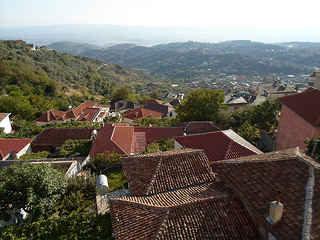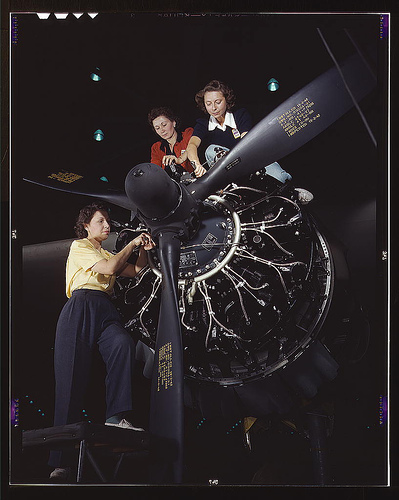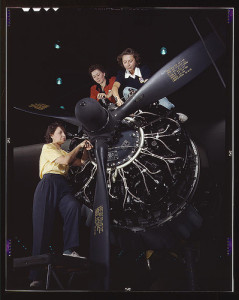I wrote up some early findings from my PhD research for conferences back in 2012 when I was working on questions around 'but will historians really use resources created by unknown members of the public?'. People keep asking me for copies of my notes (and I've noticed people citing an online video version which isn't ideal) and since they might be useful and any comments would help me write-up the final thesis, I thought I'd be brave and post my notes.
A million caveats apply – these were early findings, my research questions and focus have changed and I've interviewed more historians and reviewed many more participative history projects since then; as a short paper I don't address methods etc; and obviously it's only a huge part of a tiny topic… (If you're interested in crowdsourcing, you might be interested in other writing related to scholarly crowdsourcing and collaboration from my PhD, or my edited volume on 'Crowdsourcing our cultural heritage'.) So, with those health warnings out of the way, here it is. I'd love to hear from you, whether with critiques, suggestions, or just stories about how it relates to your experience. And obviously, if you use this, please cite it!
Exploring historians' resistance to crowdsourced resources
Scholarly crowdsourcing may be seen as a solution to the backlog of historical material to be digitised, but will historians really use resources created by unknown members of the public?
The Transcribe Bentham project describes crowdsourcing as 'the harnessing of online activity to aid in large scale projects that require human cognition' (Terras, 2010a). 'Scholarly crowdsourcing' is a related concept that generally seems to involve the collaborative creation of resources through collection, digitisation or transcription. Crowdsourcing projects often divide up large tasks (like digitising an archive) into smaller, more manageable tasks (like transcribing a name, a line, or a page); this method has helped digitise vast numbers of primary sources.
My doctoral research was inspired by a vision of 'participant digitization', a form of scholarly crowdsourcing that seeks to capture the digital records and knowledge generated when researchers access primary materials in order to openly share and re-use them. Unlike many crowdsourcing projects which are designed for tasks performed specifically for the project, participant digitization harnesses the transcription, metadata creation, image capture and other activities already undertaken during research and aggregates them to create re-usable collections of resources.
Research questions and concepts
When Howe clarified his original definition, stating that the 'crucial prerequisite' in crowdsourcing is 'the use of the open call format and the large network of potential laborers', a 'perfect meritocracy' based not on external qualifications but on 'the quality of the work itself', he created a challenge for traditional academic models of authority and credibility (Howe 2006, 2008). Furthermore, how does anonymity or pseudonymity (defined here as often long-standing false names chosen by users of websites) complicate the process of assessing the provenance of information on sites open to contributions from non-academics? An academic might choose to disguise their identity to mask their research activities from competing peers, from a desire to conduct early exploratory work in private or simply because their preferred username was unavailable; but when contributors are not using their real names they cannot derive any authority from their personal or institutional identity. Finally, which technical, social and scholarly contexts would encourage researchers to share (for example) their snippets of transcription created from archival documents, and to use content transcribed by others? What barriers exist to participation in crowdsourcing or prevent the use of crowdsourced content?
Methods
I interviewed academic and family/local historians about how they evaluate, use, and contribute to crowdsourced and traditional resources to investigate how a resource based on 'meritocracy' disrupts current notions of scholarly authority, reliability, trust, and authorship. These interviews aimed to understand current research practices and probe more deeply into how participants assess different types of resources, their feelings about resources created by crowdsourcing, and to discover when and how they would share research data and findings.
I sought historians investigating the same country and time period in order to have a group of participants who faced common issues with the availability and types of primary sources from early modern England. I focused on academic and 'amateur' family or local historians because I was interested in exploring the differences between them to discover which behaviours and attitudes are common to most researchers and which are particular to academics and the pressures of academia.
I recruited participants through personal networks and social media, and conducted interviews in person or on Skype. At the time of writing, 17 participants have been interviewed for up to 2 hours each. It should be noted that these results are of a provisional nature and represent a snapshot of on-going research and analysis.
Early results
I soon discovered that citizen historians are perfect examples of Pro-Ams: 'knowledgeable, educated, committed, and networked' amateurs 'who work to professional standards' (Leadbeater and Miller, 2004; Terras, 2010b).
How do historians assess the quality of resources?
Participants often simply said they drew on their knowledge and experience when sniffing out unreliable documents or statements. When assessing secondary sources, their tacit knowledge of good research and publication practices was evident in common statements like '[I can tell from] it's the way it's written'. They also cited the presence and quality of footnotes, and the depth and accuracy of information as important factors. Transcribed sources introduced another layer of quality assessment – researchers might assess a resource by checking for transcription errors that are often copied from one database to another. Most researchers used multiple sources to verify and document facts found in online or offline sources.
When and how do historians share research data and findings?
It appears that between accessing original records and publishing information, there are several key stages where research data and findings might be shared. Stages include acquiring and transcribing records, producing visualisations like family trees and maps, publishing informal notes and publishing synthesised content or analysis; whether a researcher passes through all the stages depends on their motivation and audience. Information may change formats between stages, and since many claim not to share information that has not yet been sufficiently verified, some information would drop out before each stage. It also appears that in later stages of the research process the size of the potential audience increases and the level of trust required to share with them decreases.
For academics, there may be an additional, post-publication stage when resources are regarded as 'depleted' – once they have published what they need from them, they would be happy to share them. Family historians meanwhile see some value in sharing versions of family trees online, or in posting names of people they are researching to attract others looking for the same names.
Sharing is often negotiated through private channels and personal relationships. Methods of controlling sharing include showing people work in progress on a screen rather than sending it to them and using email in preference to sharing functionality supplied by websites – this targeted, localised sharing allows the researcher to retain a sense of control over early stage data, and so this is one key area where identity matters. Information is often shared progressively, and getting access to more information depends on your behaviour after the initial exchange – for example, crediting the provider in any further use of the data, or reciprocating with good data of your own.
When might historians resist sharing data?
Participants gave a range of reasons for their reluctance to share data. Being able to convey the context of creation and the qualities of the source materials is important for historians who may consider sharing their 'depleted' personal archives – not being able to provide this means they are unlikely to share. Being able to convey information about data reliability is also important. Some information about the reliability of a piece of information is implicitly encoded in its format (for example, in pencil in notebooks versus electronic records), hedging phrases in text, in the number of corroborating sources, or a value judgement about those sources. If it is difficult to convey levels of 'certainty' about reliability when sharing data, it is less likely that people will share it – participants felt a sense of responsibility about not publishing (even informally) information that hasn't been fully verified. This was particularly strong in academics. Some participants confessed to sneaking forbidden photos of archival documents they ran out of time to transcribe in the archive; unsurprisingly it is unlikely they would share those images.
Overall, if historians do not feel they would get information of equal value back in exchange, they seem less likely to share. Professional researchers do not want to give away intellectual property, and feel sharing data online is risky because the protocols of citation and fair use are presently uncertain. Finally, researchers did not always see a point in sharing their data. Family history content was seen as too specific and personal to have value for others; academics may realise the value of their data within their own tightly-defined circles but not realise that their records may have information for other biographical researchers (i.e. people searching by name) or other forms of history.
Which concerns are particular to academic historians?
Reputational risk is an issue for some academics who might otherwise share data. One researcher said: 'we are wary of others trawling through our research looking for errors or inconsistencies. […] Obviously we were trying to get things right, but if we have made mistakes we don't want to have them used against us. In some ways, the less you make available the better!'. Scholarly territoriality can be an issue – if there is another academic working on the same resources, their attitude may affect how much others share. It is also unclear how academic historians would be credited for their work if it was performed under a pseudonym that does not match the name they use in academia.
What may cause crowdsourced resources to be under-used?
In this research, 'amateur' and academic historians shared many of the same concerns for authority, reliability, and trust. The main reported cause of under-use (for all resources) is not providing access to original documents as well as transcriptions. Researchers will use almost any information as pointers or leads to further sources, but they will not publish findings based on that data unless the original documents are available or the source has been peer-reviewed. Checking the transcriptions against the original is seen as 'good practice', part of a sense of responsibility 'to the world's knowledge'.
Overall, the identity of the data creator is less important than expected – for digitised versions of primary sources, reliability is not vested in the identity of the digitiser but in the source itself. Content found on online sites is tested against a set of finely-tuned ideas about the normal range of documents rather than the authority of the digitiser.
Cite as:
References
Howe, J. (undated). Crowdsourcing: A Definition http://crowdsourcing.typepad.com
Howe, J. (2006). Crowdsourcing: A Definition. http://crowdsourcing.typepad.com/cs/2006/06/crowdsourcing_a.html
Howe, J. (2008). Join the crowd: Why do multinationals use amateurs to solve scientific and technical problems? The Independent. http://www.independent.co.uk/life-style/gadgets-and-tech/features/join-the-crowd-why-do-multinationals-use-amateurs-to-solve-scientific-and-technical-problems-915658.html
Leadbeater, C., and Miller, P. (2004). The Pro-Am Revolution: How Enthusiasts Are Changing Our Economy and Society. Demos, London, 2004. http://www.demos.co.uk/files/proamrevolutionfinal.pdf
Terras, M. (2010a) Crowdsourcing cultural heritage: UCL's Transcribe Bentham project. Presented at: Seeing Is Believing: New Technologies For Cultural Heritage. International Society for Knowledge Organization, UCL (University College London). http://eprints.ucl.ac.uk/20157/
Terras, M. (2010b). “Digital Curiosities: Resource Creation via Amateur Digitization.” Literary and Linguistic Computing 25, no. 4 (October 14, 2010): 425–438. http://llc.oxfordjournals.org/cgi/doi/10.1093/llc/fqq019



